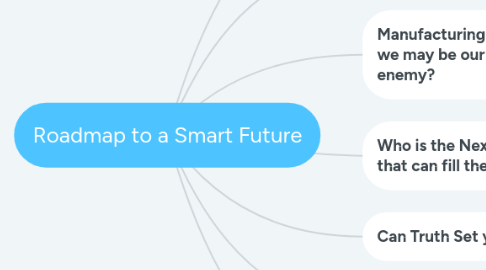
1. Catalyst for Evolution
1.1. The right current technology can drive efficiency & create a culture people want to be in
1.1.1. Value to the worker, not just mgmt
1.1.1.1. Personal value returned for solving problems in their work area
1.1.1.2. Workflow, communication & standards driven by the employee, not IT or Development
1.1.2. Visibility & value to mgmt
1.1.2.1. Mgmt aligned to workforce on real issues of the plant floor
1.1.2.1.1. Visibility to the movement and actions of the people, knowledge of how they respond and fix
1.1.2.1.2. Support workforce in solving the right issues
1.1.2.2. Impacting issues surfaced for problem solving
1.1.2.2.1. Know where investments will return value
1.1.3. Environment to draw the next generation worker
1.1.3.1. Access
1.1.3.1.1. All pertinent info available in the task
1.1.3.1.2. Data analytics to see relationships & influences
1.1.3.2. Influence
1.1.3.2.1. Analytics to show tall-poles for focused problem solving
1.1.3.2.2. Decentralized decisions to affect their work area directly
1.1.3.3. Collaboration
1.1.3.3.1. Mobile technology providing visibility to others, open communication & escalation
1.2. It's Evolution, not Revolution
1.2.1. Starting from where you are today
1.2.1.1. production has to run, focus first on knowing why it isn't
1.2.1.2. Recover incremental resource by solving a few of the big problems that consume resources - if we know their movement and actions, we know what's consuming their time.
1.2.1.3. Have a roadmap for evolution that matures each area to be problem solvers
1.2.2. Establish data integrity in current operations
1.2.2.1. Get the truth in the data from people who also will benefit from it
1.2.2.2. Establish a standard language & ability to speak the same data with a standard system
1.2.2.2.1. If it didn't go through Dispatch, it didn't happen.
1.2.3. Use visibility to impacting issues & their solutions to prioritize tech investments
1.2.3.1. Quantify the value & priority of automation/robotics, sensors, integration, etc.
1.2.3.2. Appropriate investment vs. just buying technology
1.2.4. Empowerment drives change faster than any project
2. 15 slides = 45 minutes
3. Manufacturing has Problems, are we may be our own worst enemy?
3.1. We've marginalized human capital
3.1.1. We've focused on automation as a replacement for humans
3.1.2. We don't believe people will represent the truth
3.1.3. The result -
3.1.3.1. A workforce that isn't engaged
3.1.3.2. Next gen workforce wants to work someplace else
3.1.3.3. Lack of skilled work force and low unemployment
3.2. We've built significant technical debt
3.2.1. No automation or old gen PLCs
3.2.2. Proprietary/specialized systems, disparate systems & enterprise behemoth applications
3.2.3. Result -
3.2.3.1. Can't make changes or integrate
3.2.3.2. Can't leverage Industry 4.0, AI or IoT
3.2.3.3. "Industrial Control and Factory Automation Market worth $269.5 billion by 2024" Markets and Markets
4. Can Truth Set you Free?
4.1. If the machine tell me, how long will it take to get useful intel?
4.1.1. Age of equipment may mean no integration
4.1.2. No network connectivity on the floor
4.1.3. Integration complexity requires heavy engineering skills
4.1.4. Even with skills and modern equipment, projects take years and don't achieve ROI
4.2. Why isn't it telling the truth?
4.2.1. Too difficult to make changes to align to current business
4.2.2. People don't use the system because it provides them no value
4.2.3. Maturing machine intel to be meaningful beyond simple visualization takes a very long time
4.3. How does this impact the culture on the floor?
4.3.1. No confidence in leadership because they're focused on the wrong things
4.3.2. Finger pointing in meetings, a shield to hide behinde
4.3.3. Chasing the wrong problems leaves the big problems
5. L2L Introduction
5.1. Started providing technology solution to manufacturing in 2010
5.1.1. Partnered with 23 year manufacturing expert and cloud solution tech expert
5.1.2. Provide plant floor solution that covers equipment reliability & operational availability, production at the work cell/line and closed loop quality
5.1.3. Global solution-6 continents, 19 languages, and 35 countries contracted/deployed
5.2. Do business with (logos), have never lost a customer and have 100% reference-ability
5.2.1. Have a unique approach and capability that gives plant floor employees personal value
5.2.2. We're empowering the workforce to create a new & dynamic culture of improvement
5.3. Spent 20 years leading maintenance & logistics in one of the largest organizations in the world
5.3.1. People and what motivates them
5.4. See manufacturing at risk which means our existence as a civilization is at risk
6. Who is the Next Gen workforce that can fill the skills-gap?
6.1. Are we investing in our strategic future workforce?
6.1.1. Early exposure to find passionate future workers
6.1.2. STEM programs educating/developing skill trades
6.1.3. Systems focused on workers? Lead & Driven by management?
6.1.4. We should all be doing this, but along it's not enough
6.2. New Workforce drawn to a different workplace
6.2.1. Work integrated with life-style vs. job<>life separation
6.2.1.1. Graphic
6.2.2. Desire & require access, influence and collaboration
6.2.2.1. Graphic
6.2.2.2. How has this changed from prior generations
6.2.2.2.1. Still human with a hierarchy of needs
6.2.2.2.2. Social influences via technology satisfy needs differently
6.2.3. Technology's impact on culture
6.2.3.1. Smartphones, its about the apps & access
6.2.3.2. Cloud applications & social networking
6.2.3.3. Gaming
6.2.3.3.1. Largest gamers in our population
6.2.3.3.2. Secret to attracting the players = Black vs. White Hat
6.2.4. Competition for our future workforce is defined
6.2.4.1. Google, Microsoft, Apply, Amazon, Cloud startups
6.2.4.2. quantifies what's needed to compete for skilled labor
6.3. We can leverage mobile & web technology to provide access to data, ability to impact through decentralized decisions and collaboration up/down/across
6.3.1. Not unique to Next-Gen (Facebook, Instagram, Twitter, etc.
6.3.2. Cloud solutions expedite roll-out & adoption
6.3.3. Leveraging the existing technical skills lowers the threshold for automation, digital systems, etc
6.3.4. But develop solutions/systems with focus on the workforce & their ability to make complex choices, see in complexity
